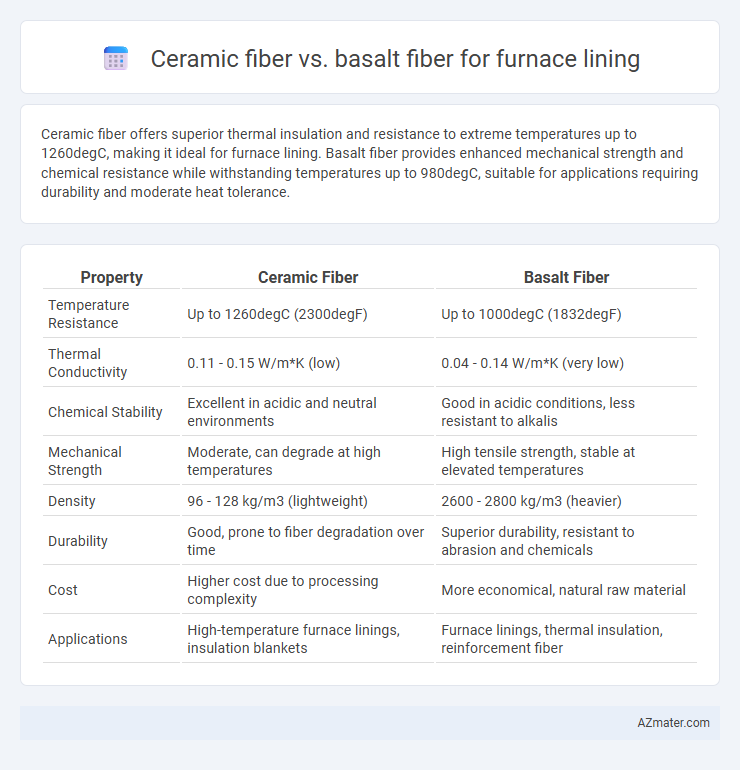Ceramic fiber offers superior thermal insulation and resistance to extreme temperatures up to 1260degC, making it ideal for furnace lining. Basalt fiber provides enhanced mechanical strength and chemical resistance while withstanding temperatures up to 980degC, suitable for applications requiring durability and moderate heat tolerance.
Table of Comparison
| Property | Ceramic Fiber | Basalt Fiber |
|---|---|---|
| Temperature Resistance | Up to 1260degC (2300degF) | Up to 1000degC (1832degF) |
| Thermal Conductivity | 0.11 - 0.15 W/m*K (low) | 0.04 - 0.14 W/m*K (very low) |
| Chemical Stability | Excellent in acidic and neutral environments | Good in acidic conditions, less resistant to alkalis |
| Mechanical Strength | Moderate, can degrade at high temperatures | High tensile strength, stable at elevated temperatures |
| Density | 96 - 128 kg/m3 (lightweight) | 2600 - 2800 kg/m3 (heavier) |
| Durability | Good, prone to fiber degradation over time | Superior durability, resistant to abrasion and chemicals |
| Cost | Higher cost due to processing complexity | More economical, natural raw material |
| Applications | High-temperature furnace linings, insulation blankets | Furnace linings, thermal insulation, reinforcement fiber |
Introduction to Furnace Lining Materials
Ceramic fiber and basalt fiber are key materials used in furnace lining, each offering distinct thermal insulation and durability properties. Ceramic fiber boasts excellent high-temperature resistance up to 1430degC and low thermal conductivity, making it ideal for lining industrial furnaces and kilns. Basalt fiber, derived from volcanic rock, provides superior mechanical strength and chemical stability at temperatures up to 980degC, offering an eco-friendly alternative with enhanced resistance to thermal shock and corrosion.
Overview of Ceramic Fiber
Ceramic fiber is an advanced refractory material composed mainly of alumina and silica, known for its excellent thermal insulation, high temperature resistance up to 1260degC to 1425degC, and low thermal conductivity. It is widely used in furnace linings due to its lightweight nature, chemical stability, and ability to withstand rapid temperature changes without degradation. Compared to basalt fiber, ceramic fiber offers superior insulating properties and higher resilience in extreme thermal environments common in industrial furnaces.
Overview of Basalt Fiber
Basalt fiber, derived from volcanic basalt rock, offers exceptional thermal stability up to 980degC, making it ideal for furnace lining applications. Its high tensile strength, chemical resistance, and eco-friendly production process provide a durable and sustainable alternative to ceramic fiber. Compared to ceramic fiber, basalt fiber exhibits lower thermal conductivity and enhanced mechanical performance, improving the longevity and energy efficiency of furnace insulation systems.
Thermal Insulation Performance Comparison
Ceramic fiber offers superior thermal insulation with a high melting point around 1760degC and low thermal conductivity approximately 0.11 W/m*K at 1000degC, making it highly effective for furnace lining at extreme temperatures. Basalt fiber, while exhibiting good thermal stability up to 980degC and thermal conductivity near 0.15 W/m*K, provides moderate insulation performance suitable for lower temperature applications. The choice between ceramic and basalt fiber hinges on the operating temperature and insulation efficiency required, with ceramic fiber excelling in high-temperature environments due to its enhanced refractory properties.
Temperature Resistance: Ceramic vs Basalt Fiber
Ceramic fiber offers exceptional temperature resistance, typically withstanding continuous use temperatures up to 1260degC (2300degF), making it ideal for high-temperature furnace linings. Basalt fiber, while strong and thermally stable, generally resists temperatures up to approximately 870degC (1600degF), which limits its application in extreme heat environments. The superior refractory properties of ceramic fiber ensure better insulation and durability for furnaces operating at elevated temperatures compared to basalt fiber.
Mechanical Strength and Durability
Ceramic fiber offers superior thermal resistance with moderate mechanical strength, making it suitable for furnace linings exposed to high temperatures but less mechanical stress. Basalt fiber exhibits higher tensile strength and better abrasion resistance, enhancing durability in environments subjected to mechanical wear and impact. Choosing basalt fiber for furnace linings improves structural integrity and prolongs service life where durability under mechanical load is critical.
Chemical Resistance and Corrosion Behavior
Ceramic fiber exhibits excellent chemical resistance against acidic and alkaline environments, maintaining structural integrity at high temperatures commonly found in furnace linings. Basalt fiber demonstrates superior corrosion resistance to molten metals and alkalis, offering enhanced durability under aggressive chemical exposures. Both fibers provide effective thermal insulation, but basalt fiber's resistance to chemical attack often extends furnace lining lifespan in highly corrosive atmospheres.
Installation and Maintenance Considerations
Ceramic fiber offers lightweight and flexible installation, allowing for easier handling and quicker setup in furnace linings, whereas basalt fiber requires more precise cutting and fitting due to its rigid structure. Maintenance of ceramic fiber involves more frequent inspections and potential replacement because of its lower mechanical strength and susceptibility to abrasion. Basalt fiber, with superior durability and thermal resistance, demands less frequent upkeep, reducing downtime and long-term maintenance costs in high-temperature environments.
Cost Efficiency and Lifecycle Analysis
Ceramic fiber offers high thermal insulation and low heat storage, reducing energy consumption in furnace lining applications, yet it generally has a higher initial cost compared to basalt fiber. Basalt fiber provides superior mechanical strength and chemical resistance, contributing to a longer service life, which can lower maintenance expenses and replacement frequency. Lifecycle analysis reveals basalt fiber's enhanced durability and cost efficiency, making it a competitive alternative despite potentially higher upfront investment.
Choosing the Right Fiber for Your Furnace Lining
Choosing the right fiber for furnace lining hinges on factors such as temperature resistance, durability, and chemical stability; ceramic fibers withstand temperatures above 1400degC and offer excellent thermal insulation, whereas basalt fibers are suitable up to 1000degC with superior mechanical strength and resistance to chemical corrosion. Ceramic fiber's low thermal conductivity and lightweight nature optimize energy efficiency, while basalt fiber's environmental sustainability and cost-effectiveness make it a popular alternative. Prioritize operating temperature and exposure conditions to ensure optimum performance and longevity of the furnace lining.

Infographic: Ceramic fiber vs Basalt fiber for Furnace lining
 azmater.com
azmater.com